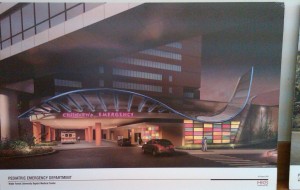Hospital construction has been rising for a few years, and according to Crain’s Chicago Business, even more health care providers are considering upgrades to their facilities. Several features on these designs have included curved steel.
From the reverse curve 8 x 8 square tubes forming the roof of the St. John’s Family Medical Care in Tulsa Oklahoma, to the 14 x 4 rectangular tube stringers in the grand stair at St. John’s in Springfield Illinois, more architects are creating buildings that draw people to them. Moreover, hospital executives are consulting hospitality industry experts to improve their overall atmosphere and add amenities usually offered by high end hotels.
Some administrators believe that these projects are necessary to accommodate the expectations of patients as consumers. Robert Kaestner, a health care economist and professor at the University of Illinois suggests that patients who can go anywhere may not choose a hospital that is deteriorating. As a result, billions of dollars are being invested in new research buildings, outpatient centers and emergency rooms which benefit the local communities’ economies as well.
Wake Forest University Baptist Medical Center completed phase I of a multi-phase renovation last year. More than 1500 construction workers were utilized on site and C.E.O. John McConnell, M.D. expects 200 permanent health care related jobs to be created now that Phase I is finished. In addition, half of the land was set aside for commercial development including banks, restaurants, hotels and shops.

The demand for high quality health care is increasing with an aging population in the United States. As hospitals expand, curved shapes will continue to be part of the trend to develop more aesthetically pleasing structures that help to improve the patients’ experiences during their visits.







